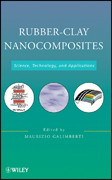
Rubber-Clay nanocomposites: science, technology, and applications
Galimberti, Maurizio
ÍNDICE: Section I. Clays for nanocomposites. 1. Clays and clay minerals. 1.1 Whats in a name. 1.2 Multiscale organization of clay minerals. 1.3 Intimate organization of the layer. 1.4 Most relevant physic-chemical properties of clay minerals. 1.5 Availability of natural clays and synthetic clay minerals. 1.6Clays and (modified) clay minerals as fillers. 1.7 References. 2. Organophilic Clay Minerals. 2.1 Organoohilicity-Lipophilicity and the Hydrophilic Balance(HLB). 2.2 From clays to organoclays in polymer technology. 2.3 Methods of organoclays synthesis. 2.4 Other types of clay modifications (for clay-based nanomaterials). 2.5 Fine-tuning of organoclays structure properties. 2.6 Some introductory reflections on organo-clay polymer nanocomposites. 2.7 References. 3. Industrial treatments and modification of clay minerals. 3.1 Bentonite: frommine to plant. 3.2 Processing of bentonite. 3.3 Purification of clay. 3.4 Reaction of clay with organic substance. 3.5 Particle size modification. 3.6 References. 4. Alkylammonium Chains on Layered Clay Mineral Surfaces. 4.1 Structure and dynamics. 4.2 Thermal properties. 4.3 Layer separation and miscibility with polymers. 4.4 Mechanical properties of clay minerals. 4.5 References. 5. Chemistry of Rubber/Organoclay Nanocomposites. 5.1 Introduction. 5.2 Organic Cation decomposition in Salts, Organoclays and Polymer Nanocomposites. 5.3 Mechanism of thermal decomposition of Organoclays. 5.4 Role of organic Cations in Organoclays as rubber vulcanization activators. 5.5 References. Section II. Preparation and characterization of rubber-clay nanocomposites. 6. Processing Methods for the Preparation of Rubber-Clay Nanocomposites. 6.1 Introduction. 6.2 Latex compounding method. 6.3 Melt compounding. 6.4 Solution intercalation andin-situ polymerization intercalation. 6.5 Summary and prospects. 6.6 References. 7. Morphology of rubber clay nanocomposites. 7.1 Introduction. 7.2 Background for the review of RCN. 7.3 Rubber clay nanocomposites with pristine clays.7.4 Rubber clay nanocomposites with clays modified with primary alkenylamines. 7.5 Rubber clay nanocomposites with clays modified with an ammonium cation having three methyls and one long alkenyl substituents. 7.6 Rubber clay nanocomposites with montmorillonite modified with two substituents larger than methyl. 7.7 Rubber clay nanocomposites with montmorillonite modified with an ammonium cation containing a polar group. 7.8 Rubber clay nanocomposites with monotmorillonite modified with an ammonium cation containing two long chain alkenyl substituents. 7.9 Proposed mechanisms for the formation of rubber clay nanocomposites. 7.10 References. 8. Rheology of rubber clay nanocomposites. 8.1 Introduction. 8.2 Rheological Behavior of Rubber/Clay Nanocomposites. 8.3 General remarks on rheology of Rubber/Clay Nanocomposites. 8.4 Overview of rheological theories of Polymer/Clay Nanocomposites. 8.5 Conclusion and outlook. 8.6 References. 9. Vulcanization Characteristics and Curi
- ISBN: 978-0-470-56210-9
- Editorial: John Wiley & Sons
- Encuadernacion: Cartoné
- Páginas: 608
- Fecha Publicación: 05/08/2011
- Nº Volúmenes: 1
- Idioma: Inglés
